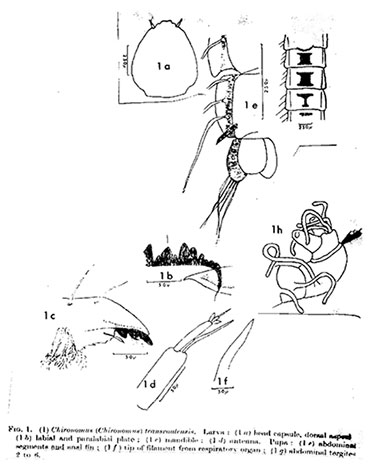Immatures of Chironomus transvaalensis Kieffer 1923For completeness, the original description of Kieffer is given below, along with the basics of the Freeman (1957) description: Type; Head yellowish. Eyes separated by less than their terminal width, slightly thinned at the top, this part less long than wide. Frontal lobes very small. Palps long, the 4th article longer. Antennae brownish yellowish, 6th segment brown black, twice as long as the 5th, 2nd narrowed in the middle, neck a little longer than wide, 3-5 with neck a little shorter than the knot (pedicel?). Mesonotum whitish, like the scutellum, three shortened bands, vitelline metanotum and mesosternum, median band divided in its posterior half into two parallel parts and brown black. Halteres greenish white. Wing hyaline, crossvein not darkened, cubital likewise as close to the wing tip as the discoidal, bifurcation beneath the transversal. Legs yellowish white, 5th tarsal segment and the extremity of 1-3 brown black, anterior metatarsus a half longer than the tibia (i.e. LR 1.5), 2-4 sub-equal, 4th twice the length of the 5th. Abdomen brown black, straight, first two segments light greenish. L. 5mm. Transvaal: Maboli, Lydenburg. Pupa: Length 6 mm. Spur of segment VIII with a single straight point. Number of hooks at base of segment II not given. Fourth instar larva: McLachlan states that the larva of this species is the largest in the Southern African region (Length 15 mm). His figures (1a-d & 1h) indicate that the larva is probably a plumosus-type. Anal tubules very long (see 1h, below).  Illustration of immature morphology from McLachlan (1969) Cytology: Wuelker, Devai & Devai (1989) published the chromosome banding sequences for Kenya populations: The African and the Israel/Pakistan species are obviously closely related but have been isolated for long enough for differentiation of COI sequence and cytology (at least of arm G) to occur. Found: |
Created: 5 September 2024
Access: Unrestricted
Copyright © 2024, Jon Martin.